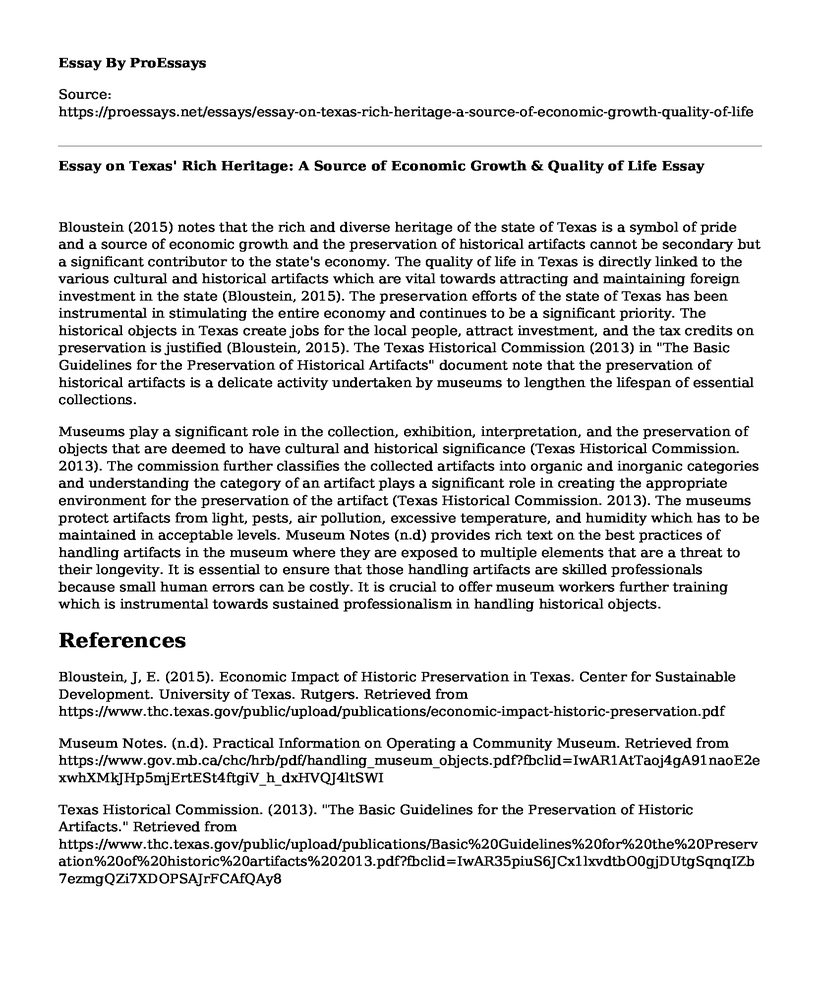Bloustein (2015) notes that the rich and diverse heritage of the state of Texas is a symbol of pride and a source of economic growth and the preservation of historical artifacts cannot be secondary but a significant contributor to the state's economy. The quality of life in Texas is directly linked to the various cultural and historical artifacts which are vital towards attracting and maintaining foreign investment in the state (Bloustein, 2015). The preservation efforts of the state of Texas has been instrumental in stimulating the entire economy and continues to be a significant priority. The historical objects in Texas create jobs for the local people, attract investment, and the tax credits on preservation is justified (Bloustein, 2015). The Texas Historical Commission (2013) in "The Basic Guidelines for the Preservation of Historical Artifacts" document note that the preservation of historical artifacts is a delicate activity undertaken by museums to lengthen the lifespan of essential collections.
Museums play a significant role in the collection, exhibition, interpretation, and the preservation of objects that are deemed to have cultural and historical significance (Texas Historical Commission. 2013). The commission further classifies the collected artifacts into organic and inorganic categories and understanding the category of an artifact plays a significant role in creating the appropriate environment for the preservation of the artifact (Texas Historical Commission. 2013). The museums protect artifacts from light, pests, air pollution, excessive temperature, and humidity which has to be maintained in acceptable levels. Museum Notes (n.d) provides rich text on the best practices of handling artifacts in the museum where they are exposed to multiple elements that are a threat to their longevity. It is essential to ensure that those handling artifacts are skilled professionals because small human errors can be costly. It is crucial to offer museum workers further training which is instrumental towards sustained professionalism in handling historical objects.
References
Bloustein, J, E. (2015). Economic Impact of Historic Preservation in Texas. Center for Sustainable Development. University of Texas. Rutgers. Retrieved from https://www.thc.texas.gov/public/upload/publications/economic-impact-historic-preservation.pdf
Museum Notes. (n.d). Practical Information on Operating a Community Museum. Retrieved from https://www.gov.mb.ca/chc/hrb/pdf/handling_museum_objects.pdf?fbclid=IwAR1AtTaoj4gA91naoE2exwhXMkJHp5mjErtESt4ftgiV_h_dxHVQJ4ltSWI
Texas Historical Commission. (2013). "The Basic Guidelines for the Preservation of Historic Artifacts." Retrieved from https://www.thc.texas.gov/public/upload/publications/Basic%20Guidelines%20for%20the%20Preservation%20of%20historic%20artifacts%202013.pdf?fbclid=IwAR35piuS6JCx1lxvdtbO0gjDUtgSqnqIZb7ezmgQZi7XDOPSAJrFCAfQAy8
Cite this page
Essay on Texas' Rich Heritage: A Source of Economic Growth & Quality of Life. (2023, Feb 12). Retrieved from https://proessays.net/essays/essay-on-texas-rich-heritage-a-source-of-economic-growth-quality-of-life
If you are the original author of this essay and no longer wish to have it published on the ProEssays website, please click below to request its removal:
- Dangers in Police Work Are Realized When Police Die in Line of Duty
- Local and Global Business Opportunities for Countries Paper Example
- Modernizing American Society (1945-1991) Essay Example
- Diabetes in Texas and Agricultural Projects in San Antonio Essay Example
- Paper Example on Appraising Townhouse Value: Which Method to Use?
- US Health Care: Ensuring Quality Care Through Compliance With Standard of Care - Research Paper
- Essay Example on Globalization Boosts Business in Hospitality Industry: Managerial Insights







